AMD's Radeon HD 5870: Bringing About the Next Generation Of GPUs
by Ryan Smith on September 23, 2009 9:00 AM EST- Posted in
- GPUs
Eyefinity
Somewhere around 2006 - 2007 ATI was working on the overall specifications for what would eventually turn into the RV870 GPU. These GPUs are designed by combining the views of ATI's engineers with the demands of the developers, end-users and OEMs. In the case of Eyefinity, the initial demand came directly from the OEMs.
ATI was working on the mobile version of its RV870 architecture and realized that it had a number of DisplayPort (DP) outputs at the request of OEMs. The OEMs wanted up to six DP outputs from the GPU, but with only two active at a time. The six came from two for internal panel use (if an OEM wanted to do a dual-monitor notebook, which has happened since), two for external outputs (one DP and one DVI/VGA/HDMI for example), and two for passing through to a docking station. Again, only two had to be active at once so the GPU only had six sets of DP lanes but the display engines to drive two simultaneously.
ATI looked at the effort required to enable all six outputs at the same time and made it so, thus the RV870 GPU can output to a maximum of six displays at the same time. Not all cards support this as you first need to have the requisite number of display outputs on the card itself. The standard Radeon HD 5870 can drive three outputs simultaneously: any combination of the DVI and HDMI ports for up to 2 monitors, and a DisplayPort output independent of DVI/HDMI. Later this year you'll see a version of the card with six mini-DisplayPort outputs for driving six monitors.

It's not just hardware, there's a software component as well. The Radeon HD 5000 series driver allows you to combine all of these display outputs into one single large surface, visible to Windows and your games as a single display with tremendous resolution.
I set up a group of three Dell 24" displays (U2410s). This isn't exactly what Eyefinity was designed for since each display costs $600, but the point is that you could group three $200 1920 x 1080 panels together and potentially have a more immersive gaming experience (for less money) than a single 30" panel.
For our Eyefinity tests I chose to use every single type of output on the card, that's one DVI, one HDMI and one DisplayPort:
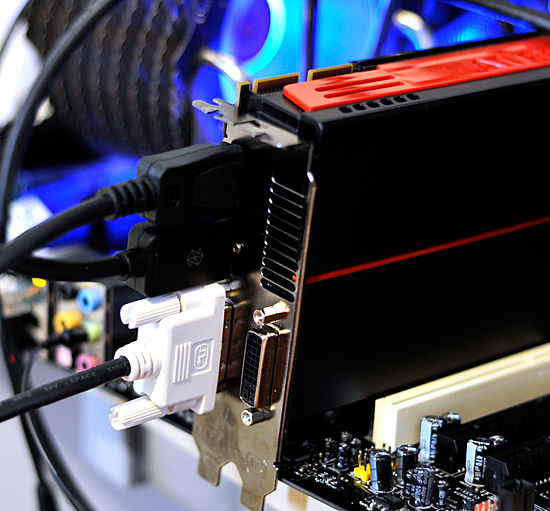
With all three outputs connected, Windows defaults to cloning the display across all monitors. Going into ATI's Catalyst Control Center lets you configure your Eyefinity groups:

With three displays connected I could create a single 1x3 or 3x1 arrangement of displays. I also had the ability to rotate the displays first so they were in portrait mode.

You can create smaller groups, although the ability to do so disappeared after I created my first Eyefinity setup (even after deleting it and trying to recreate it). Once you've selected the type of Eyefinity display you'd like to create, the driver will make a guess as to the arrangement of your panels.

If it guessed correctly, just click Yes and you're good to go. Otherwise ATI has a handy way of determining the location of your monitors:

With the software side taken care of, you now have a Single Large Surface as ATI likes to call it. The display appears as one contiguous panel with a ridiculous resolution to the OS and all applications/games:
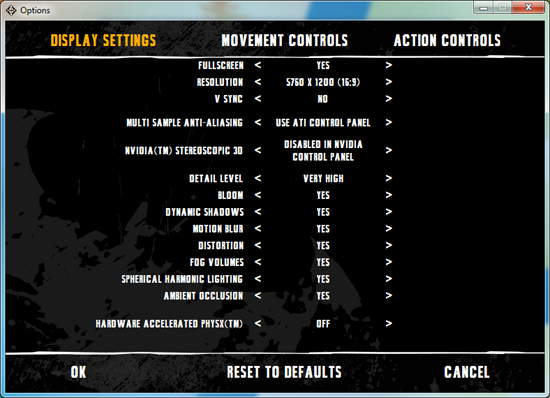
Three 24" panels in a row give us 5760 x 1200
The screenshot above should clue you into the first problem with an Eyefinity setup: aspect ratio. While the Windows desktop simply expands to provide you with more screen real estate, some games may not increase how much you can see - they may just stretch the viewport to fill all of the horizontal resolution. The resolution is correctly listed in Batman Arkham Asylum, but the aspect ratio is not (5760:1200 !~ 16:9). In these situations my Eyefinity setup made me feel downright sick; the weird stretching of characters as they moved towards the outer edges of my vision left me feeling ill.

Dispite Oblivion's support for ultra wide aspect ratio gaming, by default the game stretches to occupy all horizontal resolution
Other games have their own quirks. Resident Evil 5 correctly identified the resolution but appeared to maintain a 16:9 aspect ratio without stretching. In other words, while my display was only 1200 pixels high, the game rendered as if it were 3240 pixels high and only fit what it could onto my screens. This resulted in unusable menus and a game that wasn't actually playable once you got into it.
Games with pre-rendered cutscenes generally don't mesh well with Eyefinity either. In fact, anything that's not rendered on the fly tends to only occupy the middle portion of the screens. Game menus are a perfect example of this:
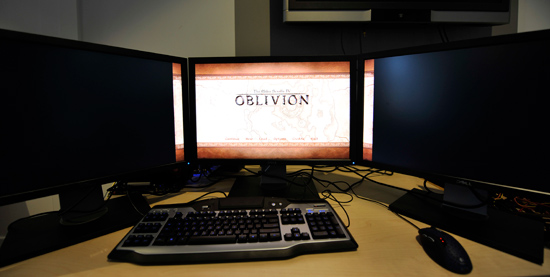
There are other issues with Eyefinity that go beyond just properly taking advantage of the resolution. While the three-monitor setup pictured above is great for games, it's not ideal in Windows. You'd want your main screen to be the one in the center, however since it's a single large display your start menu would actually appear on the leftmost panel. The same applies to games that have a HUD located in the lower left or lower right corners of the display. In Oblivion your health, magic and endurance bars all appear in the lower left, which in the case above means that the far left corner of the left panel is where you have to look for your vitals. Given that each panel is nearly two feet wide, that's a pretty far distance to look.
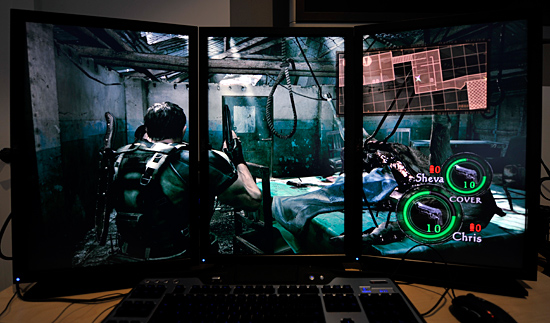
The biggest issue that everyone worried about was bezel thickness hurting the experience. To be honest, bezel thickness was only an issue for me when I oriented the monitors in portrait mode. Sitting close to an array of wide enough panels, the bezel thickness isn't that big of a deal. Which brings me to the next point: immersion.
The game that sold me on Eyefinity was actually one that I don't play: World of Warcraft. The game handled the ultra wide resolution perfectly, it didn't stretch any content, it just expanded my viewport. With the left and right displays tilted inwards slightly, WoW was more immersive. It's not so much that I could see what was going on around me, but that whenever I moved forward I I had the game world in more of my peripheral vision than I usually do. Running through a field felt more like running through a field, since there was more field in my vision. It's the only example where I actually felt like this was the first step towards the holy grail of creating the Holodeck. The effect was pretty impressive, although costly given that I only really attained it in a single game.
Before using Eyefinity for myself I thought I would hate the bezel thickness of the Dell U2410 monitors and I felt that the experience wouldn't be any more engaging. I was wrong on both counts, but I was also wrong to assume that all games would just work perfectly. Out of the four that I tried, only WoW worked flawlessly - the rest either had issues rendering at the unusually wide resolution or simply stretched the content and didn't give me as much additional viewspace to really make the feature useful. Will this all change given that in six months ATI's entire graphics lineup will support three displays? I'd say that's more than likely. The last company to attempt something similar was Matrox and it unfortunately didn't have the graphics horsepower to back it up.
The Radeon HD 5870 itself is fast enough to render many games at 5760 x 1200 even at full detail settings. I managed 48 fps in World of Warcraft and a staggering 66 fps in Batman Arkham Asylum without AA enabled. It's absolutely playable.
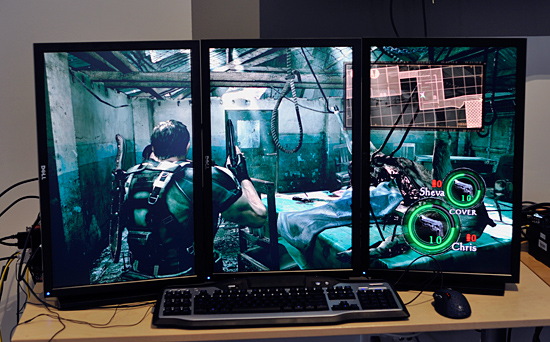










327 Comments
View All Comments
RubberJohnny - Thursday, September 24, 2009 - link
Well silicondoc you sure have some hatred for ATI/love for nvidia.It's almost as if you work for the green team...
You seem to have all this time on your hands to go around the net looking for links to spread FUD...sitting on new egg watching these cards come in and out of stock like you have a vested interest in seeing ATI fail...unlike any sane person it appears you want nvidia to have a monopoly on the industry?
Maybe you are privy to some inside info over at nvidia and know they have nothing to counter the 5870 with?
Maybe the cash they paid you to spin these BS comments would have been better spent on R&D?
SiliconDoc - Thursday, September 24, 2009 - link
That's a nice personal, grating, insulting ripppp, it's almost funny, too.---
The real problems remain.
I bring up this stuff because of course, no one else will, it is almost forbidden. Telling the truth shouldn't be that hard, and calling it fairly and honestly should not be such a burden.
I will gladly take correction when one of you noticing insulters has any to offer. Of course, that never comes.
Break some new ground, won't you ?
I don't think you will, nor do I think anyone else will - once again, that simply confirms my factual points.
I guess I'll give you a point for complaining about delivery, if that's what you were doing, but frankly, there are a lot of complainers here no different - let's take for instance the ATI Radeon HD 4890 vs. NVIDIA GeForce GTX 275 article here.
http://www.anandtech.com/video/showdoc.aspx?i=3539">http://www.anandtech.com/video/showdoc.aspx?i=3539
Boy, the red fans went into rip mode, and Anand came in and changed the articles (Derek's) words and hence "result", from GTX275 wins to ATI4890 wins.
--
No, it's not just me, it's just the bias here consistently leans to ati, and wether it's rooting for the underdog that causes it, or the brooding undercurrent hatred that surfaces for "the bigshot" "greedy" "ripoff artist" "nvidia overchargers" "industry controlling and bribing" "profit demon" Nvidia, who knows...
I'm just not afraid to point it out, since it's so sickening, yes, probably just to me, "I'm sure".
How about this glaring one I have never pointed out even to this day, but will now:
ATI is ALWAYS listed first, or "on top" - and of course, NVIDIA, second, and it is no doubt, in the "reviewer's minds" because of "the alphabet", and "here we go in alphabetical order".
A very, very convenient excuse, that quite easily causes a perception bias, that is quite marked for the readers.
But, that's ok.
---
So, you want to tell me why I shouldn't laugh out loud when ATI uses NVIDIA cards to develope their "PhysX" competition Bullet ?
ROFLMAO
I have heard 100 times here (from guess whom) that the ati has the wanted "new technology", so will that same refrain come when NVIDIA introduces their never before done MIMD capable cores in a few months ? LOL
I can hardly wait to see the "new technology" wannabes proclaiming their switched fealty.
Gee sorry for noticing such things, I guess I should be a mind numbed zombie babbling along with the PC required fanning for ati ?
silverblue - Thursday, September 24, 2009 - link
No; if he did work for nVidia, he'd be far better informed and far less prone to using the phrase "red rooster" every five seconds.crackshot91 - Wednesday, September 23, 2009 - link
Any possibility of benchmarks with a core 2 duo?I wanna know if it will be necessary to upgrade to an i5 or i7 (All new mobo) to see big performance gains over my 8800GT. Will a C2D E6750 @ 3.2GHz bottleneck it?
Ryan Smith - Wednesday, September 23, 2009 - link
Our recent Core i7 860 article should do an adequate job of answering that question. Several of the benchmarks were taken right out of this article.therealnickdanger - Wednesday, September 23, 2009 - link
You dedicated a full page to the flawless performance of its A/V output, but didn't mention it in the "features" part of the conclusion. It's a very powerful feature, IMO. Granted, this card may be a tad too hot and loud to find a home in a lot of HTPCs, but it's still an awesome feature and you should probably append your conclusion... just a suggestion though.Ultimately, I have to admit to being a little disappointed by the performance of this card. All the Eyefinity hype and playable framerates at massive 7000x3000 resolutions led me to believe that this single card would scale down and simply dominate everything at the 30" level and below. It just seems logical, so I was taken aback when it was beat by, well, anything else. I expected the 5870 and 5870CF to be at the top of every chart. Oh well.
Awesome article though! I'm sure there's a 5850 in my future!
MrMom - Wednesday, September 23, 2009 - link
Does anyone have a good explanation why the massive HD5870 is still slower/@par with the GTX295?Thanks
SiliconDoc - Thursday, September 24, 2009 - link
Yes, because the ati core "really sucks". It needs DDR5, and much higher MHZ to compete with Nvidia, and their what, over 1 year old core. LOL Even their own 4870x2.Or the 3 year old G92 vs the ddr3 "4850" the "topcore" before yesterday. (the ati topcore minus the well done 3m mhz+ REBRAND ring around the 4890)
That's the sad, actual truth. That's the truth many cannot bear to bring themselves to realize, and it's going to get WORSE for them very soon, with nvidia's next release, with ddr5, a 512 bit bus, and the NEW TECHNOLOGY BY NVIDIA THAT ATI DOES NOT HAVE MIMD capable cores.
Oh, I can hardly wait, but you bet I'm going to wait, you can count on that 100%.
Spoelie - Thursday, September 24, 2009 - link
because those are 2 480mm² dies, while this is only 1 360mm² die?Griswold - Wednesday, September 23, 2009 - link
Its one GPU instead of two, maybe?